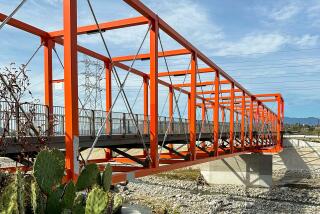Suspense Story : Wrong Man Gets Credit for Golden Gate Bridge, Author Says
- Share via
SAN FRANCISCO — The soaring beauty and delicate strength of the red steel bridge that spans the Golden Gate has been attributed for the last 50 years to the wrong man, according to a San Francisco author.
Hundreds of visitors get their picture taken every day next to a plaque identifying the builder of the bridge as Joseph Strauss, a diminutive bridge construction businessman from Chicago.
But the design presented by Strauss, who was better at railroad trestles, was an Erector Set atrocity that probably could never have been built and would have blown down in a good wind if it had been.
John van der Zee, who can see the inspiring towers of the Golden Gate Bridge from his home in San Francisco, says the official accounts giving Strauss credit for the spectacular structure that fits so perfectly across the entrance of the bay are myth.
“Strauss just wasn’t an engineer,” Van der Zee said in an interview. “He drew a design for a bridge over the gate. It was a combination of cantilever and suspension. It never would have worked. The wind would have set it vibrating and ripped it apart.”
Then who did design the great span that so graciously links San Francisco to the rest of Northern California?
Van der Zee says the real engineering genius of the world’s most spectacular bridge is Charles Alton Ellis, an Illinois professor who translated Greek for fun and wrote 10 volumes of mathematical stress formulas to show that nearly a mile of light roadbed could be hung from strands of cable suspended between two huge towers footed 200 feet below the roiling surface of the bay’s entrance.
A Great Promoter
“Strauss was a great promoter, and he was good at getting press and organizing people,” Van der Zee said. “He went around Northern California with this picture of the proposed bridge. He was so very proud of it that he had it patented.
“It was a combination of cantilever and suspension. He claimed he could build it for $17 million. But a study said it would cost $112 million if it could be built at all. And no engineer of any stature was willing to get involved.”
In order to get a realistic bridge design, Strauss, who did not even have an engineering degree, hired Ellis, a young engineer from the University of Illinois who was familiar with the latest bridge-building techniques and theories.
“With its immense, spidery framework and thick, crosshatched girder towers, Strauss’ original design suggests an enormous railroad bridge, dark and ponderous, a soulless mechanism . . . something out of the early industrial era of soot and smoke and pounding repetitious noise,” Van der Zee writes in his book, “Gate,” to be published Feb. 12.
Ellis brought into consultation Leon S. Moisseiff, designer of the Manhattan Bridge over the East River in New York, who had developed some new theories about suspension bridges.
“Moisseiff was the theoretician, the guy who had ideas for a long-span suspension bridge. It was his idea that if all the mathematics were worked out accurately and stresses calculated, then as much as half the wind stress could be transferred to the cables and could be transmitted to the towers and abutments. This meant bridges could be built longer and narrower and cheaper than anybody previously thought,” Van der Zee said.
As designed by Ellis, the span construction was budgeted for $35 million and came in under that figure.
Although the engineering detail was worked out by Ellis, credit for some of the intriguing beauty of the Golden Gate span belongs to another man, Irving Foster Morrow, who added touches such as the fluting and art deco tower treatment that make the bridge look different in every light of day.
Painting it red was Morrow’s idea. “He saw the hills of reddish rock in Marin, and the warm greens of the Presidio in San Francisco. He thought that, because of its size, the bridge should have a warm color, not the gray that a lot of people wanted, or the yellow and black stripes that the Navy wanted the bridge to have,” Van der Zee said.
Insists on Taking Credit
The author said Strauss remained jealous of the fact that “his” bridge was designed by someone else. He insisted throughout the construction of the span and afterward that no one but himself should get credit. He fired Ellis before the construction was finished.
The bridge directors went along with Strauss and never mentioned anyone else in the press releases and official accounts of the bridge’s construction.
“Like many another man who has achieved a certain eminence in major matters, Strauss remained dismayingly petty in minor ones,” Van der Zee said. “Nowhere on the plaque, nor in any of the news stories concerning completion of the bridge, nor in any of the press releases or promotional material published by the bridge district, then or since, was any mention made of Charles Ellis.”
Strauss died May 16, 1938, and was immediately enshrined as the man who built the Golden Gate Bridge.
Ellis died in 1949. In its obituary on Ellis, the Chicago Tribune identified him as the bridge’s designer. But then, the Tribune had said the same thing of Strauss.
More to Read
Sign up for The Wild
We’ll help you find the best places to hike, bike and run, as well as the perfect silent spots for meditation and yoga.
You may occasionally receive promotional content from the Los Angeles Times.






